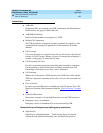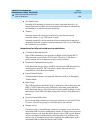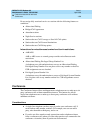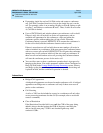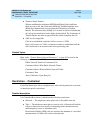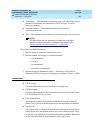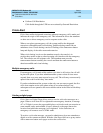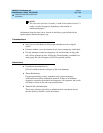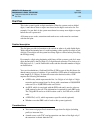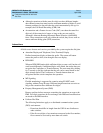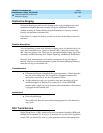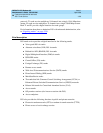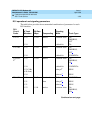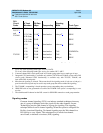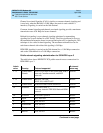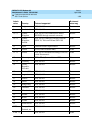
DEFINITY ECS Release 8.2
Administrator’s Guide
555-233-506
Issue 1
April 2000
Features and technical reference
1315Dial Plan
20
Dial Plan
This is the system’s guide to digit translation. When the system receives dialed
digits, it must know what to expect next based on the digits received so far. For
example, if a user dials 4, the system must know how many more digits to expect
before the call is processed.
All feature access codes, extensions and trunk access codes must be consistent
with the dial plan.
Detailed description
The dial plan provides information to the switch on what to do with dialed digits.
Tables define the intended use of a code beginning with a specific first digit or pair
of digits. These digits tell the system how many digits to collect before processing
the full digit string.
For example, a digit string beginning with 8 may tell the system to wait for 4 more
digits because this is the first digit of a 5-digit internal extension. The choices of a
first digit are 0–9, *, and #. Permissible codes and the allowable number of digits
are listed below.
You can also administer a Uniform Dial Plan (UDP) as part of the dial plan to be
shared among a group of switches. If you establish a UDP, make all extensions the
same length (4 or 5 digits). So that calls route to the desired switch, a UDP
requires the following information:
■ A PBX code, which represents the first 1 to 5 digits of a 4-digit or 5-digit
extension and can range from 0 to 9xxxx with a maximum of 50,000 PBX
codes on G3r or 20,000 PBX codes on G3si/csi.
■ An RNX, which is associated with the PBX code and is used to select an
AAR pattern for the call. This information is required for each PBX code.
The 3-digit RNX can be an AAR location code or, for ENP calls, an ENP
code.
■ A PBX ID (1 to 63), which represents a specific switch (optional).
■ Whether or not the PBX code is local to this system (optional).
Considerations
■ You cannot assign prefixed extensions longer than five digits (including
prefix) to intercom lists.
■ A trunk access code (TAC) and an extension can share a first digit only if
the extension is shorter than the TAC.



